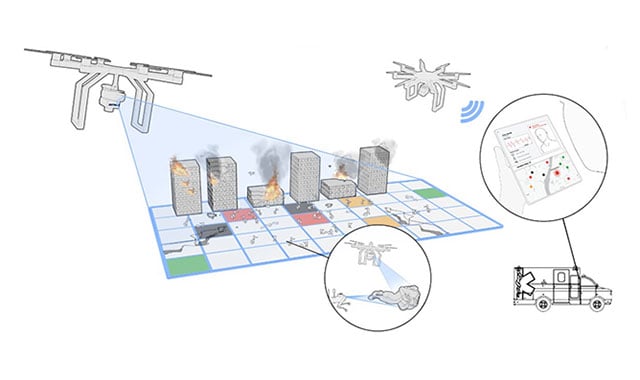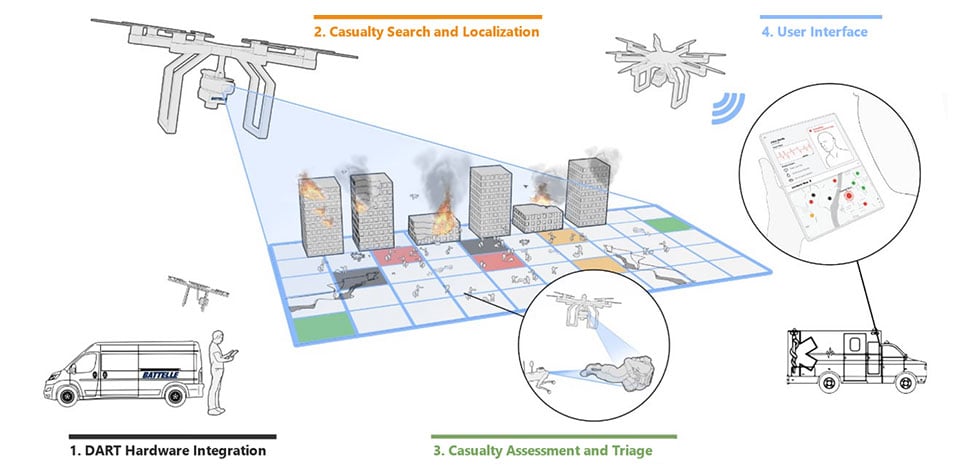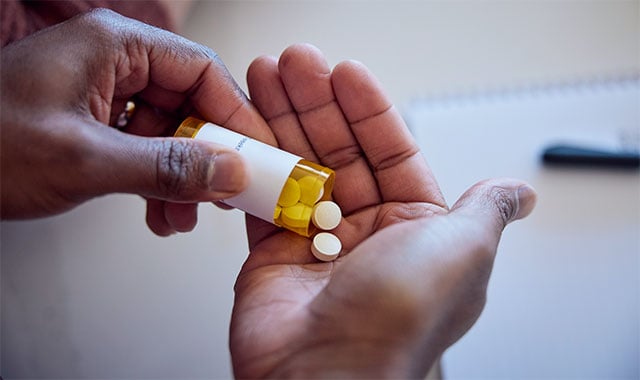Tackling the Challenge of Mass Casualty Triage with Technology

Mass casualty incidents can occur anytime and anywhere, making it difficult for first responders to provide immediate assistance. Despite these difficulties, they remain a constant presence, triaging patients and stabilizing them until transportation is available.
Triage of mass casualties is a demanding task, especially in hazardous situations where resources are limited, and medical personnel are outnumbered. In such cases, casualties must be prioritized to provide the greatest good for the most significant number of people in the shortest time.
Addressing Mass Casualty Incidents
To address these challenges, organizations like the Defense Advanced Research Projects Agency (DARPA) seek to apply technology to assist emergency responders in locating critically injured survivors, assessing their injuries, and determining who to transport first.
“Triage of mass casualties is always a challenge,” said Carl Blaesing, Battelle Environmental Scientist III in the Health Research & Analytics business, who has firsthand experience in disaster response. “There is an almost unbearable burden of making triage decisions in real-time, especially if these decisions are with individuals, you actually know. The human emotional element and decision regret have a high mental health impact on first responders. Having a collaborative decision support system will simultaneously make the response more efficient and much less stressful for those responding.”
The DARPA Triage Challenge
The Defense Advanced Research Projects Agency (DARPA) is seeking to apply technology to assist emergency responders in locating critically injured survivors, assessing their injuries, and determining who to transport first. The DARPA Triage Challenge aims to drive breakthrough innovations in identifying physiological signatures of injury that will help medical responders perform scalable, timely, and accurate triage.
Battelle is one of a dozen DARPA-funded teams taking on the DARPA Triage Challenge (DTC). For Battelle, it is a multiphase-funded contract worth $3.75 million over three years and a competition with prize money, up to $7 million across the primary and secondary triage challenges.
Watch the video to learn more about the DARPA Triage Challenge.
How We're Solving for Mass Casualty Triage
Battelle’s solutions are intended to supplement the expertise of emergency responders and healthcare professionals in civilian and military settings. Using remote sensors, the goal is to keep first responders out of harm’s way, collect data beyond human capacity, rapidly distill vast amounts of information, reduce cognitive load, and assist on-site clinicians in making timely and informed decisions in complex and stressful situations.
The challenge comprises a series of simulated mass casualty incidents designed to assess the primary and secondary stages of triage. The primary stage requires the support of sensors on stand-off platforms like uncrewed aircraft vehicles (UAVs). In contrast, the secondary stage uses non-invasive contact sensors to identify those needing medical intervention.

Model of Battelle's mass casualty triage system.
Image Credit: Emma Coughlin and Russ Kittel
Primary Triage: An Autonomous Sensor-Based System
For primary triage, Battelle is creating a system that uses air- and ground-based autonomous vehicles to search for and locate casualties. Sensors, including phased acoustic microphone arrays, ultrawideband radar, electro-optical imaging, and infrared imaging, will be used to find individuals and collect physiological data. With data on massive hemorrhage, mobility, respiration, circulation, and hypothermia, custom machine learning models and expert rule models will identify which individuals need lifesaving interventions.
“The thing that gets me up in the morning is the opportunity to work on amazing, innovative technology that makes a positive societal impact,” said Sam Colachis, Biomedical Engineer III on Battelle’s Medical Device Solutions team and principal investigator for the primary triage portion of the challenge. “While this project is different from what I’ve been doing in neurotechnology for the last several years, it leverages the same problem-solving methodologies and multidisciplinary approach. I’m thrilled to be part of this team using exciting technology to create solutions to help first responders and the people they serve.”
Secondary Triage: A Data-Based Algorithm
Battelle is developing an algorithm for secondary triage to support decision-making once a patient is attached to contact sensors, such as those in an ambulance or hospital. Using a data fusion approach, the algorithm will look at a wide range of information from electronic health records (EHRs) and real-time sensors, demographics, known injuries, preliminary tests, and vital signs to predict which patients need life-saving interventions and when. The team will use a statistical process control method, developed initially as part of Battelle’s NeuroLife® technology, to remove inaccurate data from incorrectly applied sensors or other background interference.
“This is an amazing opportunity to work with actual trauma center patient data,” said Collin Dunlap, Data Scientist II in Battelle’s Health Research & Analytics business line and principal investigator for the secondary triage portion of the challenge. “These institutions have astronomical amounts of data—vital signs many times per second for thousands of patients per year. Using this data to create algorithms to predict the need for lifesaving interventions is really impactful work.”
What's Next for Mass Casualty Triage and the DARPA Challenge
The DARPA Triage Challenge includes three challenge events, each increasing in complexity. For primary triage, Battelle will physically test their hardware and software system in mock mass casualty events staged with actors and mannequins to correctly locate and assess injuries of as many casualties as possible in an allotted timeframe. For secondary triage, the team will receive data feeds they’ve never encountered and use their algorithms to predict which patients need lifesaving interventions.
Although the Battelle team just started implementing their technical concepts a few short months ago, they are hopeful for their chances of success. The diversity of expertise within the organization, along with our in-house Institutional Review Board that enables human subjects research, is essential.
“What makes Battelle unique from other competitors is our breath of experience,” said Tom Mera, Health Program Manager. “We have pulled together a diverse team of engineers and scientists spanning Medical Device Solutions and other parts of the organization, including health data analytics, machine learning, military hardware development, and sensor integration, as well as learning from colleagues with emergency response experience.”
Related Blogs
BATTELLE UPDATES
Receive updates from Battelle for an all-access pass to the incredible work of Battelle researchers.








